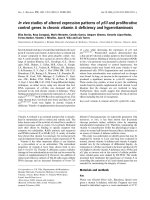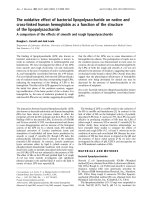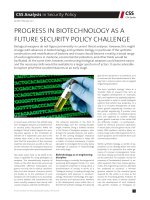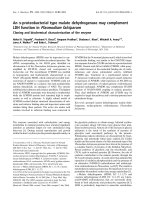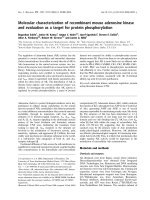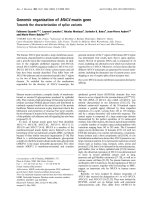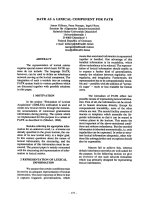Characterization of Spin Coated Polymers in Nano-environments as a Function of Film Thickness pot
Bạn đang xem bản rút gọn của tài liệu. Xem và tải ngay bản đầy đủ của tài liệu tại đây (4.57 MB, 80 trang )
Characterization of Spin Coated Polymers in Nano-environments
as a Function of Film Thickness
Catherine E. Beck
Thesis submitted to the Faculty of the
Virginia Polytechnic Institute and State University
in partial fulfillment for the requirements for the degree of
Master of Science
in
Chemistry
Thomas C. Ward, Chair
Alan R. Esker
John G. Dillard
July 26, 2001
Blacksburg, VA
Keywords: Thin films, Cooperativity, Polymer Brushes
ii
Characterization of Spin Coated Polymers in Nano-environments
as a Function of Film Thickness
(Abstract)
Catherine E. Beck
Polymer applications have become more demanding as industry continuously
turns to more microscopic parts. Due to the interactions of the polymer chains with the
supporting surface and the air interface, the thinner films required for such applications
have distinctly different properties than those of the well-defined bulk systems. The goal
of the current research is to elucidate the behavior of ultrathin films. Two separate
studies were performed on thin films supported on silicon wafer substrates: the first
focuses on the viscoelastic cooperativity of thin films, and the second concentrates on the
morphological behavior of polymer brush films.
For the first study, polymethyl methacrylate films were spin coated onto silicon
wafers, and the film thickness was determined using ellipsometry. A series of thin films
were examined using techniques such as dielectric analysis and thermal mechanical
analysis. The theory of cooperativity, which explains polymeric behavior using the
intermolecular and intramolecular forces among polymer chains, was employed to
understand the behavior of these thin films.
Another type of thin film, a polymer brush, was investigated in the second study.
Polymer brushes are formed by chemically bonding one end of many polymer chains to a
substrate. The other ends of the chains can interact with the surrounding environment
creating a brush-like structure. Constraining one end of a polymer chain alters the
behavior of such a thin film. Polymer brushes of the di-block copolymer poly(t-butyl
methacrylate) and polystyrene were produced on silicon wafers using spin coating
techniques. The effects of both grafting density and solvent washes were analyzed using
contact angle analysis and atomic force microscopy. In addition, hydrolysis was
successfully performed on existing polymer brush samples to produce polymer brushes of
the di-block copolymer polymethyl acrylic acid and polystyrene.
Table of Contents
1 Chapter I Introduction 1
2 Chapter II Literature Review 2
2.1 Cooperativity 2
2.2 Thin Films 5
2.3 Spin Coating 8
2.4 Ellipsometry 10
2.5 Dielectric Analysis 11
2.6 Thermal Mechanical Analysis 12
2.7 Polymer Brushes 12
2.8 Contact Angles 16
2.9 Atomic Force Microscopy 17
3 Chapter III Experimental 19
3.1 Cooperativity Studies 19
3.2 Polymer Brush Studies 22
4 Chapter IV Results and Discussion: Cooperativity Studies 27
4.1 Differential Scanning Calorimetry 27
4.2 Gel Permeation Chromatography 28
4.3 Ellipsometry 29
4.4 Dielectric Analysis 32
4.5 Thermal Mechanical Analysis 36
4.6 Summary of Cooperativity Studies 39
5 Chapter V Results and Discussion: Polymer Brush Studies 40
5.1 Contact Angles 40
5.2 X-ray Photoelectron Spectroscopy 42
5.3 Ellipsometry 47
5.4 Atomic Force Microscopy 48
5.5 Summary of Polymer Brush Studies 70
ii
List of Figures
Figure 2.1-1: Temperature dependence of the shift factor for several polymers 4
Figure 2.2-1: Substrate-polymer interactions of PMMA on silicon. 7
Figure 2.2-2: Change of T
g
with film thickness 8
Figure 2.3-1: Stages of spin coating 9
Figure 2.7-1: Polymer brush chain conformations. 13
Figure 2.7-2: Brush height versus grafting amount for homopolymers (R
g
= radius of
gyration) 14
Figure 2.7-3: Brush height versus grafting density for di-block copolymers 14
Figure 2.7-4: Polymer brush self-assembly of a di-block copolymer 15
Figure 2.8-1: Contact Angle Analysis 16
Figure 3.1-1: Schematic of Dielectric Instrument 21
Figure 3.2-1: Chemical structure of di-block copolymer 22
Figure 4.1-1: DSC scan of PMMA (Endotherm Up) 27
Figure 4.2-1: GPC results for PMMA 28
Figure 4.3-1: Film Thickness versus Spin Speed for each sample 30
Figure 4.3-2: Film thickness vs. solution concentration for the 3000 rpm samples 31
Figure 4.4-1: DEA results for clean silicon wafer, permittivity as temperature increased32
Figure 4.4-2: DEA of clean silicon wafer 33
Figure 4.4-3: DEA results of 50 nm PMMA film on silicon 34
Figure 4.4-4: DEA results of a second 50 nm film sample on silicon 35
Figure 4.4-5: DEA results of a second clean silicon wafer sample 36
Figure 4.5-1: 900 nm DMA 37
Figure 4.5-2: TMA results of 50 nm film of PMMA, no apparent transition 38
Figure 4.5-3: TMA results of 660 nm film superimposed on blank silicon wafer 39
Figure 5.1-1: Contact angles of water on copolymer brush samples 41
Figure 5.2-1: XPS elemental analysis of oxygen on 20t sample 45
Figure 5.2-2: XPS elemental analysis of oxygen on 20ht sample 45
Figure 5.2-3: XPS elemental analysis of carbon on 20t sample 46
Figure 5.2-4: XPS elemental analysis of carbon on 20ht sample 46
Figure 5.4-1: AFM image of a clean silicon wafer 49
iii
Figure 5.4-2: 3-D AFM image of a clean silicon wafer 49
Figure 5.4-3: AFM image of 40t sample after 10 hours of toluene wash 50
Figure 5.4-4: AFM image of 100t sample after 10 hours of toluene wash 51
Figure 5.4-5: AFM images of 10t sample 52
Figure 5.4-6: 3-D AFM image of 10t sample. 52
Figure 5.4-7: AFM images of 20t sample 53
Figure 5.4-8: 3-D AFM image of 20t sample. 53
Figure 5.4-9: AFM images of 40t sample 54
Figure 5.4-10: 3-D AFM image of 40t sample. 54
Figure 5.4-11: AFM images of 100t sample 55
Figure 5.4-12: 3-D AFM image of 100t sample. 55
Figure 5.4-13: AFM images of 40ht sample 57
Figure 5.4-14: 3-D AFM image of 40ht sample. 57
Figure 5.4-15: AFM images of 100ht sample 58
Figure 5.4-16: 3-D AFM image of 100ht sample. 58
Figure 5.4-17: AFM images of 100c sample. 59
Figure 5.4-18: 3-D AFM image of 100c sample 59
Figure 5.4-19: AFM images of 100hc sample. 60
Figure 5.4-20: 3-D AFM image of 100hc sample 60
Figure 5.4-21: Summary chart of the average height difference for each polymer brush
sample. 62
Figure 5.4-22: Height analysis of AFM image for 10t sample 63
Figure 5.4-23: Height analysis of AFM image for 20t sample 64
Figure 5.4-24: Height analysis of AFM image for 40t sample 65
Figure 5.4-25: Height analysis of AFM image for 100t sample 66
Figure 5.4-26: Height analysis of AFM image for 40ht sample 67
Figure 5.4-27: Height analysis of AFM image for 100ht sample 68
Figure 5.4-28: Height analysis of AFM image for 100c sample. 69
Figure 5.4-29: Height analysis of AFM image for 100hc sample. 70
iv
List of Tables
Table 2.1-1: Coupling parameters of several polymers 3
Table 2.8-1: Contact angle results for polymethacrylates. 17
Table 4.3-1: Film Thickness and error for 2% PMMA solution 29
Table 4.3-2: Film Thickness and error for 5% PMMA solution 29
Table 4.3-3: Film Thickness and error for 10% PMMA solution 29
Table 5.1-1: Contact angles for methylene iodide 42
Table 5.1-2: Surface energy with dispersive and polar components. 42
Table 5.2-1: XPS results (15°), atomic concentration table for one measurement of 20ht
sample. 43
Table 5.2-2: XPS results (90°), atomic concentration table for one measurement of 20ht
sample. 43
Table 5.2-3: XPS results (15°), atomic concentration table for one measurement of 20t
sample. 44
Table 5.2-4: XPS results (90°), atomic concentration table for one measurement of 20t
sample. 44
Table 5.3-1: Di-block sample film thickness from ellipsometry after 10 hours of washing
47
Table 5.3-2: Di-block sample film thickness from ellipsometry after 34 hours of washing
48
1
1 Chapter I
Introduction
This thesis describes the behavior of ultrathin polymer films supported on a
silicon wafer substrate. Two separate studies have been performed: the first focuses on
the viscoelastic cooperativity of thin films, and the second concentrates on the
morphological behavior of polymer brush films.
Industrial use of thin films has increased for several reasons including the
development of ever-smaller electronic devices. As applications of polymers become
smaller and thinner, the behavior of polymer chains in these confined geometries needs to
be understood. Many aspects need to be probed such as the effect of molecular weight,
thermal degradation, and the adhesion properties. In the first study, one characterization
scheme, cooperativity, was chosen to summarize the influence of the small scale on
polymer behavior. The theory of cooperativity focuses on polymer chain interactions and
relates those interactions to macroscopic behavior. This research looks specifically at the
well-defined system of polymethyl methacrylate and silicon to understand better how
cooperativity reveals polymeric behavior in thin films.
The second study focuses on a new type of thin film, polymer brushes. By
chemically bonding one end of many polymer chains to a substrate, leaving the other
ends free to interact with a second environment, one can create a brush-like structure.
The constraints placed on these polymer chains produce a range of morphological
behavior depending on a number of factors. When exposed to different solvents, the
chain conformations are variable. This thesis reports the effects of chemical composition
and variable solvents on di-block copolymer brushes.
2
2 Chapter II
Literature Review
2.1 Cooperativity
2.1.1 Cooperative Motion
Unlike simple molecules, polymers have a distribution of relaxation times. This
non-exponential nature of the relaxation functions of polymers has led to the
development of many theories to model their behavior, especially near the glass
transition. In 1965, Adam and Gibbs stated that polymer relaxations occur via groups of
molecules which rearrange cooperatively.
1
This idea of cooperative relaxation was an
important move towards defining the role of polymer interaction in relaxation
phenomena.
More recently, Angell developed a theory describing the ‘fragility’ of a system.
2
Fragile liquids experienced structural degradation as the temperature of the system
increases above the glass transition. Conversely, strong liquids held onto their structural
integrity longer due to their network structures. Ngai and Plazek extended these concepts
of intermolecular and intramolecular forces to polymeric behavior with the introduction
of the coupling model.
3
This model depicted the relaxation of macromolecules as many
individual segmental relaxations. But, such local relaxations must involve the molecules
in the surrounding environment through coupling interactions among the polymer chains.
These interactions depended on the amount of intermolecular and intramolecular forces,
or the cooperativity, of the polymer. A coupling parameter, n, was also defined in the
model to give a quantitative measure of the cooperativity. It ranged from a value of 0 for
materials that experienced little coupling to 1 for materials that demonstrated more
coupling or a higher cooperativity. In addition, the coupling model relates the coupling
parameter to the breadth of the relaxation distribution- the higher the coupling parameter
or cooperativity, the broader the relaxation times for the polymer. Because of their
mutual emphasis on interactions within and between molecules, the concept of fragility
and the coupling model are closely related.
3
Due to the dependence of cooperativity on intermolecular interactions, chemical
structure pays a large role in the coupling parameter. Ngai and Roland have explored the
effect of chemical structure on the cooperativity of polymers.
4
An increase of
intermolecular forces, such as dipoles or hydrogen bonding, can amplify the cooperativity
of the system. Ngai's results are summarized in a table of coupling parameters calculated
for different polymers. An excerpt of these results appears in Table 2.1-1.
Table 2.1-1: Coupling parameters of several polymers.
5
Glass Former
n = 1-β (at T
g
)
Polybutadiene 1,2 0.74
Polycarbonate (BPA-PC) 0.65
Poly(methylmethacrylate) 0.63
Polybutadiene 1,4 0.58
Poly(vinylacetate) 0.52
Polyisoprene 0.50
2.1.2 Cooperative Analysis
Ngai and Plazek developed a relationship between the "primitive relaxation
times," τ
o
, and the measured relaxation times, τ*.
6
Because τ
o
was dependent on both
temperature and molecular weight, the relaxation times were related to the coupling
parameter, n, where ω
c
is a coupling crossover frequency.
()
[]
()
n
o
n
c
n
−
∗
−=
1/1
1
τωτ
(1)
The relationship of a
T
, explained as a ratio of relaxation times
)(/)(
RT
TTa
∗∗
=
ττ
(2)
where T
R
is a reference temperature and T is the temperature of the measurement, was
applied to Equation 1. This ratio gave the following equation after substitution.
4
)(
)(
log
)(
)(
log)1(log)1(
Ro
o
R
T
T
T
T
T
nan
τ
τ
τ
τ
=−=−
∗
∗
(3)
In Ngai and Plazek’s publications, they determined that numerous sets of data
could be reconciled with the well known Williams-Landel-Ferry Equation.
6
If the glass
transition temperature (T
g
) was utilized as the reference temperature, then:
gg
gg
T
TTTC
TTTC
an
/)(
/)(
log)1(
2
1
−+
−−
=− (4)
The empirical parameters C
1
and C
2
were calculated to be 5.49 and 0.141 respectively
and can be used to determine n.
In addition to the numerical values, the free-standing, neat polymer systems were
also compared using cooperativity plots. These plots place log a
T
on the y-axis and (T-
T
g
)/T
g
on the x-axis. For these graphs, a steeper slope reflects a higher coupling
parameter. A series of polymers is represented by such a plot in Figure 2.1-1.
Figure 2.1-1: Temperature dependence of the shift factor for several polymers
6
5
2.2 Thin Films
Many bulk polymer properties have been well defined in the recent literature.
7
In
addition, theories that offer reasoning for changes in these bulk properties with
temperature, pressure, etc. have been developed. Focus has been shifted in the past
decade to polymers in thin film geometries. These systems remain obscure to polymer
scientists.
Thin films have become ubiquitous in the polymer industry. Fueled by the
microelectronics industry and its need for miniature parts, polymer applications have
become more demanding. Polymers in these environments have been tested and modeled
in laboratories around the world: from universities to automobile companies, research
surrounding thin films is quickly growing.
8
Two main areas of research have emerged that cover thin polymer films. The
first, free-standing films, investigates thin films unattached to a substrate. The main
concern in this field is how the air-polymer interface affects the behavior of the polymer
as the film decreases in thickness. The second, polymer films on substrates, focuses on
the interactions at the polymer-substrate interface. Both research fields have reported
data and offered explanations for what has been observed. Although the second area is
more relevant to the current research, the two interrelate, so the literature for each appears
below.
2.2.1 Free-Standing Films
The major difference in bulk polymer properties and those of a thin, free-standing
film is the proximity of the polymer-air interface. The mobility of the polymer chains at
this interface is an important concern to applications such as adhesion, melt pressing, and
latex film formation.
9
This mobility also affects the glass transition temperature (T
g
), a
prominent property of polymers. In general, as the film thickness decreases, the T
g
also
decreases - as much as 60°C in free-standing films. Ngai explains this decrease using the
coupling model.
10
His paper cites two factors that contribute to the lower transition
temperature. First, as the film thickness approaches the average end-to-end distance,
6
induced orientation can occur in the film. Of course, this condition applies mostly for
ultrathin films of high molecular weight polymers. Second, the polymer chains that are
near the surface of the polymer have a higher mobility (or what Ngai calls a decrease in
the “cooperative length scale.”
10
) The chains near the surface interact with proportionally
less polymer chains than those in the center. Their coupling parameter decreases due to
fewer interactions, mobility increases, and therefore, the depression in T
g
is observed.
Here, Ngai provides a crucial link of the glass transition temperature as a measure of the
cooperativity of the polymer. Of course, a measured T
g
represents some ensemble
average of "surface" and "bulk" polymer.
Although useful for modeling, most thin film applications are not free-standing, but
confined to a substrate. These confined geometries present new challenges as the effects
of more than one interface must be considered.
2.2.2 Polymer Films on Substrates
Current research has focused on the task of defining thin film behavior when the
polymer is cast on a surface. Although the theories developed for free-standing films
apply to the free surface of the system, the effect of the substrate on polymer properties
needed to be investigated. Keddie et al. observed polymethyl methacrylate (PMMA) on
two different substrates, the native oxide of silicon and gold evaporated onto silicon.
9
The two systems produced drastically different results as measured by spectroscopic
ellipsometry. As the polymer film thickness decreased, the PMMA on the gold surface
showed a decrease in the T
g
whereas the PMMA on the silicon surface showed an
increase at the same thickness. Keddie argued that PMMA does not have a favorable
interaction with gold; therefore the effect of the polymer-air interface would dominate the
mobility of the polymer and result in the change in T
g
. Conversely, hydrogen bonding
can occur between the hydroxyl groups of the silicon surface and the oxygen in PMMA
as seen in Figure 2.2-1. In this system, the substrate interactions would dominate the
behavior of the polymer. Wallace used similar reasoning stating that the interactions with
the surface could act as a crosslink in the polymer by restraining certain chains.
11
For
thin films, those less than approximately 60 nm, significant increases in T
g
could occur.
7
These researchers saw shifts of as much as 60°C. Van Zanten chose a different polymer,
poly-(2)- vinyl pyridine, to cast on silicon.
12
This polymer should interact more strongly
with the silicon than PMMA and also show an increase in T
g
. Indeed transition
temperatures increased anywhere from 20°C to 50°C above the bulk T
g
as observed by x-
ray reflectometry. In addition, these researchers calculated that the effects of the surface
extended several hundreds of angstroms into the polymer.
12
CH
2
C
C
O CH
3
n
CH
3
O
OH
OH
OH
OH
Figure 2.2-1: Substrate-polymer interactions of PMMA on silicon.
Thin films on substrates provide a characterization challenge: the whole system
must be measured at once and substrate properties can easily mask those of the thin film.
Other techniques have been employed to study these complex systems. Fryer et al. used
local thermal analysis to probe polystyrene (PS) and PMMA on two different
substrates.
13
These results were comparable to ellipsometry values establishing local
thermal analysis as an effective technique. Again, PS did not have a favorable interaction
with the polar or nonpolar silicon surface and both PS systems showed a decrease in T
g
with decreasing film thickness. PMMA showed similar behavior on the nonpolar surface.
However, on the polar substrate the T
g
increased as the PMMA films became thinner.
Porter saw similar effects measuring PMMA on silica with a differential scanning
8
calorimeter (DSC).
14
The DSC showed an increase of 50°C above the bulk T
g
for films
of 0.6 Å.
An excellent summary is provided by a macromolecular simulation done by
Torres et al.
15
Using hard spheres as polymer models and programming desired polymer-
interface interactions, the group was able to duplicate selected experimental results.
Their data for a free-standing film, a polymer-interface weak interaction, and a polymer-
interface strong interaction can be seen in Figure 2.2-2. This research aids in
understanding the behavior of thin polymer films. Free-standing films have increased
mobility at two surfaces, a decreased coupling parameter, and therefore lower T
g
’s as the
films become thinner. For films with weak substrate-polymer interactions, the T
g
also
dropped although not as sharply since these films only have one free surface. Inversely,
polymer-substrate interactions that are strong produce an increased cooperativity and
therefore a higher T
g
as films become thinner.
Figure 2.2-2: Change of T
g
with film thickness.
2.3 Spin Coating
Many techniques needed to be developed to create and monitor these new thin
film systems. An accurate method for producing thin polymer films was the first
objective of this thesis research. The proposed solution to the problem was spin coating.
First a polymer solution was made and was pipetted onto the desired surface. Next, the
9
substrate was “accelerated to a desired rotation rate.”
16
Spinning continued until an
equilibrium film thickness was reached. This was followed by annealing to alleviate
radial orientation and eliminate any remaining solvent.
Several variables can control the film thickness of the final product. Extrand
looked at some of the experimental parameters in spin coating.
17
The solvent used to
make the solution does affect the final thickness of the film. Different viscosity and
solubility can make PMMA films cast from a cyclohexane solution twice as thick as
those cast from a toluene solution.
17
The research also showed that thickness increased as
spin speed decreased as would be expected. The amount of solution applied to the wafer
did not affect the thickness as long as there was enough present to cover the surface. Any
excess was simply flung off the surface by centripetal forces.
Because thin films are used in so many applications, Bornside, Macosko, and
Scriven developed a model for achieving a desired film thickness.
18
They divided spin
coating into the four stages of deposition, spin-up, spin-off, and evaporation (Figure 2.3-
1). By taking both the force of spinning and the concentration-controlled evaporation
into account, these researchers were able to predict film thickness. This model was
extremely useful because it included the surface chemistry and the type of polymer used.
Because of the dependable nature of the method and the ease of use, spin coating is
frequently used to create polymer thin films.
Figure 2.3-1: Stages of spin coating
18
10
2.4 Ellipsometry
2.4.1 Theory
Ellipsometry uses polarized light to analyze optical properties of diverse samples.
The linearly polarized light is reflected off the sample surface. Data are taken across an
area of the surface and averaged to give a more accurate representation of the properties
for the entire film. For a spectroscopic ellipsometers, a range of light from 350 nm to
1000 nm is used to acquire a spectrum. After reflection, the light becomes elliptically
polarized. The analyzer measures the orientation and the direction of the reflected light.
From these values, the phase change, ∆, and the amplitude change, ψ, can be calculated.
19
When working with a known polymer, its index of refraction is required to allow for a
fitting of the actual film thickness.
2.4.2 Applications
The recent interest in thin film research has been aided by more refined
ellipsometers and their characterization ability. Initially, the instrument was employed to
find the film thickness of static samples.
17,20
The data was expanded to include the index
of refraction for known and unknown polymers.
21
New developments then turned to
heating stages to measure the dynamic properties of thin films. As the sample was
heated, the change in film thickness could be monitored. Similar to dilatometry data, the
expansion plotted against temperature gave a change in slope at the T
g
. Many groups
began acquiring transition temperatures with this method.
9,13
With the ability to calculate
T
g
of the whole system, the ellipsometer became an indispensable tool in thin film
characterization.
11
2.5 Dielectric Analysis
2.5.1 Theory
Dielectric Analysis (DEA) is used to measure the loss modulus, storage modulus,
and thus temperature transitions of polymers. Specifically, DEA studies the motion of
the polymer chain. As the sample is placed into the electric field produced by the
instrument, polar polymer chains react by orienting along the field. This polarity mainly
arises from polar bonds in the chain or from polar side groups. Low temperature
transitions can be assigned to side chain motion, usually involving rotations via DEA.
High temperature transitions manifest larger, whole chain motion. These transitions are
indicative of the T
g
.
22
In addition, DEA can measure these polymer motions over a wide
range of frequencies: 10
-5
to 10
9
Hz.
23
This ability makes DEA a powerful
characterization technique, particularly when time-temperature superposition is applied.
24
By recording the response of the polymer chains to the electric field, the dielectric
permittivity, loss, and cooperativity of the polymer can be measured.
2.5.2 Applications
Dielectric analysis of bulk polymer properties has been well documented.
22
Similarly, DEA has often been employed in monitoring polymer reactions.
22
Another,
quite common application uses DEA to measure the breadth of a polymer relaxation.
25
This analysis is directly related to the coupling parameter, which quantifies cooperativity.
DEA has been used for characterizing thin polymer films.
8
However, the polymer
systems that have been studied involve free-standing films that have been sputter coated
on both sides. Adding conductive substrates, such as aluminum foil, has also been
accomplished,
8
as well as relying on sputter coated, conducting surfaces.
12
2.6 Thermal Mechanical Analysis
2.6.1 Theory
Thermal mechanical analysis can be used to assess the glass transition of a thin
film system. The sample is placed in a temperature-controlled chamber for analysis.
Two different probes can be used with thermal mechanical analysis (TMA): a flat probe
or a penetration probe.
26
The flat probe measures the thermal expansion of the polymer as
the temperature is increased. Very little load is applied, so an accurate measure of
change in dimension can be reported. Conversely, the penetration probe can have up to
1.0 N of force placed on the sample. The probe pushes into the sample as it softens to
give a crude modulus (or compliance) value or a temperature associated with a
transition.
26
2.6.2 Applications
For bulk polymers, both the coefficient of thermal expansion and the modulus
have been measured as mentioned above.
26
A more sensitive procedure has been
developed for thin film analysis called local thermal analysis (LTA). In this technique
the probe itself is heated and is therefore able to measure the expansion and transitions of
thin films more accurately.
13
2.7 Polymer Brushes
An advancement in thin film polymers has appeared in the last 20 years. By
chemically bonding one end of many polymer chains to a substrate, a monolayer of
polymer chains can be manufactured. By tethering one end of a polymer chain to the
surface, its motion is restricted. Several chain conformations have been proposed such as
the mushrooms and clusters as seen in Figure 2.7-1.
13
Figure 2.7-1: Polymer brush chain conformations.
27
The number of chains bonded to a given area of the substrate is known as the
grafting density. As this density increases, intermolecular crowding forces the chains to
take on stretched conformations, or a longer end-to-end distance, which differs from the
characteristic random-walk of a free polymer. Therefore, increasing the surface
concentration of polymer chains leads to an increase in film thickness or height (h). This
relationship between grafting density and polymer brush height can be seen in both
homopolymers (Figure 2.7-2) and di-block copolymers (Figure 2.7-3).
14
Figure 2.7-2: Brush height versus grafting amount for homopolymers (R
g
= radius of
gyration).
27
Figure 2.7-3: Brush height versus grafting density for di-block copolymers.
27
15
The stretched polymer configuration changes the film mechanical properties as
well as the film morphology. The polymer film thickness that ultimately occurs is a
result of a complex balance of free energy factors.
28
The usual random-walk
conformation must compete with the desire of the polymer to stretch out in a good
solvent. Because of these competing forces, it is not unusual for the height of the film to
be greater than the radius of gyration for the polymer.
Diblock copolymers can also exhibit self-assembled layers. Although the first
chain is grafted to the substrate, subsequent chains can assemble in stacked layers by
alternating their orientation. In other words, the A-block can be bonded to the surface
leaving the B-block at the air (or solvent) interface; the next chain can place the B-block
down to favorably interact with the first B-block, and leave the A-block up and so on,
alternating layers. An illustration of this self-assembly is shown in Figure 2.7-4.
Figure 2.7-4: Polymer brush self-assembly of a di-block copolymer.
27
Many characterization techniques for polymer brushes such as light scattering,
nuclear magnetic resonance, atomic force microscopy, and contact angle measurements
appear in the literature.
28
Previous papers have demonstrated morphological differences
due to the molecular weight of polymer chains
28
and even differences caused by the last
solvent used to wash the brush.
29
The work of Zhao, et al. showed brush morphologies
changing from smooth, after washing in CH
2
Cl
2
, to a worm-like structure and then to a
hemispherical shape as cyclohexane was slowly added to the wash solution.
29
Changing
16
the solvent composition by as little as 10 % induced drastic contrast in polymer brush
behavior. Previous work by Wang, et al.
30
has been continued in this present thesis
research to understand better the morphological changes due to grafting density and
solvent washes.
2.8 Contact Angles
2.8.1 Theory
By measuring the contact angle between a solid surface and a free-standing liquid
drop, the relative energetics between the two can be evaluated. For example, if a drop of
water beads up on a substrate, then the surface likely has nonpolar or hydrophobic
characteristics. Conversely, if water wets the substrate, then the surface is more likely
polar or hydrophilic. Figure 2.8-1 illustrates the definition of the contact angle (θ) and
the relevant surface energy values.
Figure 2.8-1: Contact Angle Analysis
31
In addition to this simple characterization, by measuring the contact angle using
two different liquids, the solid surface energy can be calculated. This total energy (γ) is
often decomposed into the sum of polar (γ
p
) and dispersive (γ
d
) components. Using the
measured contact angle and published surface energy values for water and methylene
iodide, a form of Young's Equation can be solved simultaneously to obtain surface
energy values.
31
17
+
+
+
=+
p
s
p
p
s
p
d
s
d
d
s
d
γγ
γγ
γγ
γγ
γθ
1
1
1
1
11
4)cos1(
(5)
+
+
+
=+
p
s
p
p
s
p
d
s
d
d
s
d
γγ
γγ
γγ
γγ
γθ
2
2
2
2
22
4)cos1((6)
2.8.2 Applications
Contact angles give a macroscopic picture of the surface. This technique quickly
assesses surface properties for applications such as adhesion and wetting.
31
In molecular
terms, specific backbone or side chain compositions have been examined by contact
angle analysis. Wulf, et al. looked at the influence of the side chain groups in polyalkyl
methacrylates.
32
Their conclusions showed a gradual increase of the contact angle of
water and a decrease of the polymer surface energy as the side group increased in size or
bulk. Some of the results for polyt-butyl methacrylate (PtBMA), polyn-butyl metharylate
(PnBMA), and polymethyl methacrylate (PMMA) can be viewed in Table 2.8-1.
32
Table 2.8-1: Contact angle results for polymethacrylates.
θw (PMMA)
31
80°
γ
sv
(PMMA)
32
38.5 ± 0.5 dyne/cm
θw (PnBMA)
31
91°
γ
sv
(PnBMA)
32
28.8 ± 0.5 dyne/cm
θw (PtBMA)
32
108.08° ± 0.53
γ
sv
(PtBMA)
32
18.1 ± 0.6 dyne/cm
2.9 Atomic Force Microscopy
2.9.1 Theory
Atomic force microscopy (AFM) maps out the topographical features of a surface.
A miniature tip (radius of curvature is 5-10 nm
40
), usually made of silicon or silicon
nitride, taps along a prescribed area of the surface being imaged.
33
Attractive and
repulsive electrostatic forces affect the motion of the tip as it operates close to the
surface. A piezoelectric scanning actuator works in a feedback loop to raise or lower the
18
cantilever beam that holds the tip, thus maintaining constant amplitude of oscillation as
the surface height changes. A laser beam records the deflection of the cantilever beam as
the tip rasters along the surface. Typically a height image, monitoring relative elevation,
and a phase image, analogous to relative modulus, are produced.
2.9.2 Applications
Many different surface measurements can be done on a microscopic scale using
AFM. In the tapping mode described above, phase images show the well-defined
boundaries of phase separations. Height images give a topographical map of the surface.
Both the height and phase image can be used together to create a complete picture of the
surface morphology. Also, tips can be used in the more destructive contact mode to
measure friction or adhesion by dragging along the surface.
19
3 Chapter III
Experimental
3.1 Cooperativity Studies
3.1.1 Material
It has been demonstrated that chemical structure directly affects cooperativity.
34
To simplify the research, one amorphous polymer with a high molecular weight was
chosen. Polymethyl methacrylate (PMMA) was purchased from Aldrich in the powder
form. Gel permeation chromatography showed a Mw of 101,300 g/mol with a
polydispersity of 1.967.
3.1.2 Sample Preparation
3.1.2.1 Surface Treatment
Polished silicon wafers one inch in diameter and ~0.30 mm thick were purchased
from Wafer World, Inc. The wafers were held isothermally at 90°C for 90 minutes in a
30/70 solution by volume of H
2
O
2
and H
2
SO
4
respectively.
35
Next, they were submersed
in acetone in a sonicator for 30 minutes. The wafers were then rinsed with acetone and
dried in a stream of air. This treatment produced a native oxide layer on the silicon
wafers that were used as the substrate for depositing thin films of PMMA.
3.1.2.2 Spin Coating
Solutions of PMMA in toluene were prepared at 2%, 5%, and 10% by weight.
The silicon wafers were positioned on the spin coater and several drops of solution were
placed on the wafer. Immediately, each sample began rotating at a constant speed to
